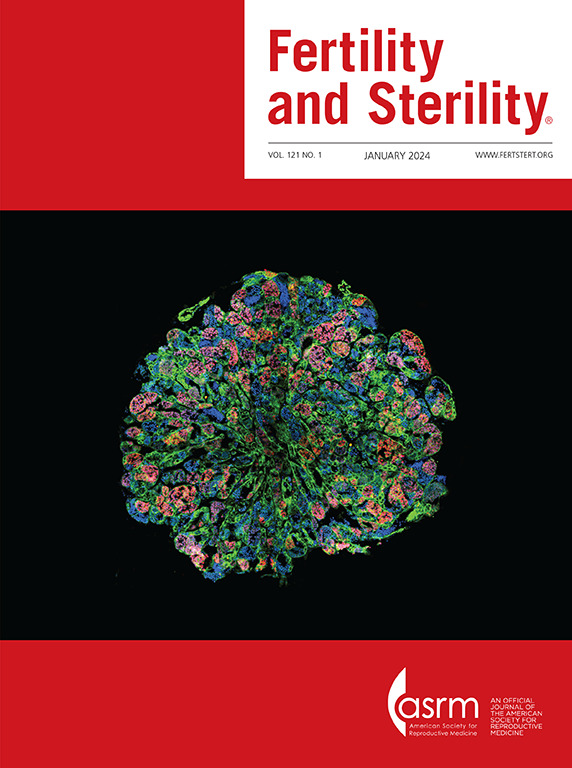Hormone-free vs. follicle-stimulating hormone–primed infertility treatment of women with polycystic ovary syndrome using biphasic in vitro maturation: a randomized controlled trial
IF 6.6
1区 医学
Q1 OBSTETRICS & GYNECOLOGY
引用次数: 0
Abstract
Objective
To compare oocyte maturation rates and pregnancy outcomes in women with polycystic ovary syndrome (PCOS) undergoing biphasic in vitro maturation (capacitation in vitro maturation [CAPA-IVM]) with vs. without follicle-stimulating hormone (FSH) priming.
Design
Randomized, controlled, assessor-blinded trial.
Subjects
Women aged 18–37 years with PCOS and an indication for CAPA-IVM.
Intervention(s)
Participants were randomized (1:1) to undergo CAPA-IVM with or without FSH priming. The FSH priming group had 2 days of FSH injections before oocyte pickup; no FSH was given in the non-FSH group. After CAPA-IVM, day-5 embryos were vitrified for transfer in a subsequent cycle.
Main Outcome Measure(s)
The primary endpoint was number of matured oocytes. Secondary outcomes included rates of live birth, implantation, clinical pregnancy, ongoing pregnancy, pregnancy complications, obstetric and perinatal complications, and neonatal complications.
Result(s)
The number (interquartile range) of matured oocytes did not differ significantly in the non-FSH vs. FSH group (13 [9–18] vs. 14 [7–18]; absolute difference –1 [95% confidence interval –5 to 4]); other oocyte and embryology outcomes did not differ between groups. Rates of ongoing pregnancy and live birth were 38.3% in the non-FSH group and 31.7% in the FSH group (risk ratio for both outcomes: 1.21, 95% confidence interval 0.74–1.98). Maternal complications were infrequent and occurred at a similar rate in the two groups; there were no preterm deliveries before 32 weeks gestation.
Conclusion(s)
These findings open the possibility of a new, hormone-free approach to infertility treatment of women with PCOS.
Clinical Trail Registration Number
NCT05600972.
Tratamiento de infertilidad sin uso de hormonas vs. preparado de hormona folículo estimulante en mujeres con síndrome de ovario poliquístico sometidas a maduración in vitro bifásica: un ensayo controlado aleatorizado
Objetivo
Comparar las tasas de maduración de ovocitos y los resultados del embarazo en mujeres con síndrome de ovario poliquístico (SOP) sometidas a maduración in vitro bifásica (maduración in vitro de capacitación [CAPA-IVM]) con y sin preparado de hormona folículo estimulante (FSH).
Diseño
Ensayo aleatorizado, controlado, con evaluador ciego.
Contexto
Hospital privado.
Pacientes
Mujeres de 18 a 37 años con SOP e indicación de CAPA-IVM.
Intervención
Las participantes fueron asignadas al azar (1:1) para someterse a CAPA-IVM con o sin preparado de FSH. El grupo con FSH recibió 2 días de inyecciones de FSH antes de la recolección de ovocitos; no se administró FSH en el grupo sin FSH. Después de CAPA-IVM, los embriones del día 5 fueron vitrificados para su transferencia en un ciclo posterior.
Medida principal de resultado(s)
El criterio de valoración principal fue el número de ovocitos maduros.Los resultados secundarios incluyeron tasas de nacimientos vivos, implantación, embarazo clínico, embarazo en curso, complicaciones del embarazo, complicaciones obstétricas y perinatales, y complicaciones neonatales.
Resultado(s)
El número (rango intercuartil) de ovocitos maduros no difirió significativamente en el grupo sin FSH frente al grupo con FSH (13 [9–18] vs. 14 [7–18]; diferencia absoluta –1 [95 % intervalo de confianza –5 a 4]); Otros resultados de ovocitos y embriología no difirieron entre los grupos. Las tasas de embarazo en curso y nacidos vivos fueron del 38,3% en el grupo sin FSH y del 31,7% en el grupo con FSH (cociente de riesgo para ambos resultados: 1,21; intervalo de confianza del 95%: 0,74 a 1,98). Las complicaciones maternas fueron poco frecuentes y ocurrieron a una tasa similar en los dos grupos; no hubo partos prematuros antes de las 32 semanas de gestación.
使用双相体外成熟法治疗多囊卵巢综合征妇女不孕症的无激素疗法与 FSH 促排卵疗法:随机对照试验。
目的比较多囊卵巢综合征(PCOS)女性患者在接受双相体外成熟(获能[CAPA]-IVM)与不接受卵泡刺激素(FSH)启动治疗时的卵母细胞成熟率和妊娠结局:随机、对照、评估者盲法试验 对象: 18-37 岁患有多囊卵巢综合征的女性:年龄在 18-37 岁之间、患有多囊卵巢综合症且有 CAPA-IVM 适应症的女性:受试者被随机(1:1)安排接受CAPA-IVM,同时接受或不接受FSH诱导。FSH启动组在卵母细胞采集前注射两天FSH;非FSH组不注射FSH。CAPA-IVM后,第5天的胚胎进行玻璃化处理,以便在随后的周期中进行移植:主要终点是成熟卵母细胞数。次要结果包括活产率、植入率、临床妊娠率、持续妊娠率、妊娠并发症、产科和围产期并发症以及新生儿并发症:结果:非 FSH 组与 FSH 组的成熟卵母细胞数[四分位间范围]无显著差异(13 [9-18] 对 14 [7-8];绝对差异-1 [95% 置信区间 (CI) -5,4]);其他卵母细胞和胚胎学结果在组间无差异。非 FSH 组持续妊娠率和活产率均为 38.3%,FSH 组均为 31.7%(两种结果的风险比:1.21,95% CI 0.74-1.98)。两组产妇并发症的发生率相似,而且都不常见;妊娠 32 周前没有早产现象:这些发现为治疗多囊卵巢综合症妇女不孕症提供了一种不含激素的新方法。
本文章由计算机程序翻译,如有差异,请以英文原文为准。
求助全文
约1分钟内获得全文
求助全文
来源期刊

Fertility and sterility
医学-妇产科学
CiteScore
11.30
自引率
6.00%
发文量
1446
审稿时长
31 days
期刊介绍:
Fertility and Sterility® is an international journal for obstetricians, gynecologists, reproductive endocrinologists, urologists, basic scientists and others who treat and investigate problems of infertility and human reproductive disorders. The journal publishes juried original scientific articles in clinical and laboratory research relevant to reproductive endocrinology, urology, andrology, physiology, immunology, genetics, contraception, and menopause. Fertility and Sterility® encourages and supports meaningful basic and clinical research, and facilitates and promotes excellence in professional education, in the field of reproductive medicine.
 求助内容:
求助内容: 应助结果提醒方式:
应助结果提醒方式:


